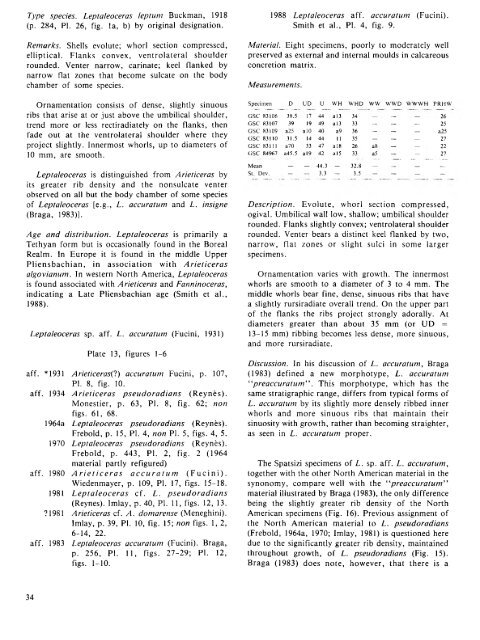PLIENSBACHIAN (LOWER JURASSIC) BIOSTRATIGRAPHY AND ...
PLIENSBACHIAN (LOWER JURASSIC) BIOSTRATIGRAPHY AND ...
PLIENSBACHIAN (LOWER JURASSIC) BIOSTRATIGRAPHY AND ...
Create successful ePaper yourself
Turn your PDF publications into a flip-book with our unique Google optimized e-Paper software.
Type species. Leptaleoceras leptum Buckman, 1918<br />
(p. 284, PI. 26, fig. la, b) by original designation.<br />
Rem arks. Shells evolute; whorl section compressed,<br />
elliptical. Flanks convex, ventrolateral shoulder<br />
rounded. Venter narrow, carinate; keel flanked by<br />
narrow flat zones that become sulcate on the body<br />
chamber of some species.<br />
Ornamentation consists of dense, slightly sinuous<br />
ribs that arise at or just above the umbilical shoulder,<br />
trend more or less rectiradiately on the flanks, then<br />
fade out at the ventrolateral shoulder where they<br />
project slightly. Innermost whorls, up to diameters of<br />
10 mm, are smooth.<br />
Leptaleoceras is distinguished from Arieticeras by<br />
its greater rib density and the nonsulcate venter<br />
observed on all but the body chamber of some species<br />
of Leptaleoceras [e.g., L. accuratum and L. insigne<br />
(Braga, 1983)].<br />
A g e and distribution. Leptaleoceras is primarily a<br />
Tethyan form but is occasionally found in the Boreal<br />
Realm. In Europe it is found in the middle Upper<br />
Pliensbachian, in association with A rie tic e ra s<br />
algovianum . In western North America, Leptaleoceras<br />
is found associated with Arieticeras and Fanninoceras,<br />
indicating a Late Pliensbachian age (Smith et al.,<br />
1988).<br />
Leptaleoceras sp. aff. L. accuratum (Fucini, 1931)<br />
Plate 13, figures 1-6<br />
aff. *1931 Arieticeras(7) accuratum Fucini, p. 107,<br />
PI. 8, fig. 10.<br />
aff. 1934 A rie tic e ra s p se u d o ra d ia n s (Reynes).<br />
Monestier, p. 63, PI. 8, fig. 62; non<br />
figs. 61, 68.<br />
1964a Leptaleoceras pseudoradians (Reynes).<br />
Frebold, p. 15, PI. 4, non PI. 5, figs. 4, 5.<br />
1970 Leptaleoceras pseudoradians (Reynes).<br />
Frebold, p. 443, PI. 2, fig. 2 (1964<br />
material partly refigured)<br />
aff. 1980 A r i e t i c e r a s a c c u r a t u m (F u c in i).<br />
Wiedenmayer, p. 109, PI. 17, figs. 15-18.<br />
1981 L e p ta le o c e ra s cf. L . p s e u d o r a d ia n s<br />
(Reynes). Imlay, p. 40, PI. 11, figs. 12, 13.<br />
71981 Arieticeras cf. A . domarense (Meneghini).<br />
Imlay, p. 39, PI. 10, fig. 15; non figs. 1, 2,<br />
6-14, 22.<br />
aff. 1983 Leptaleoceras accuratum (Fucini). Braga,<br />
p. 256, PI. 11, figs. 27-29; PI. 12,<br />
figs. 1-10.<br />
1988 Leptaleoceras aff. accuratum (Fucini).<br />
Smith et al., PI. 4, fig. 9.<br />
Material. Eight specimens, poorly to moderately well<br />
preserved as external and internal moulds in calcareous<br />
concretion matrix.<br />
Measurements.<br />
Specim en D UD U W H W H D WW W W D W W W H P R H W<br />
G SC 83106 38.5 17 44 a 13 34 __ _ — 26<br />
G SC 83107 39 19 49 a 13 33 - — - 25<br />
G SC 83109 a25 alO 40 a9 36 - — — a25<br />
G SC 83110 31.5 14 44 11 35 — — - 27<br />
G SC 83111 a70 33 47 a 18 26 a8 — — 22<br />
G SC 84967 a45.5 a l9 42 a l 5 33 a5 - — 27<br />
M ean — _ 44.3 — 32.8 _ _ ___ ___<br />
Si. Dev. — 3.3 — 3.5 — — — —<br />
D escription. Evolute, whorl section compressed,<br />
ogival. Umbilical wall low, shallow; umbilical shoulder<br />
rounded. Flanks slightly convex; ventrolateral shoulder<br />
rounded. Venter bears a distinct keel flanked by two,<br />
narrow, flat zones or slight sulci in some larger<br />
specimens.<br />
Ornamentation varies with growth. The innermost<br />
whorls are smooth to a diameter of 3 to 4 mm. The<br />
middle whorls bear fine, dense, sinuous ribs that have<br />
a slightly rursiradiate overall trend. On the upper part<br />
of the flanks the ribs project strongly adorally. At<br />
diameters greater than about 35 mm (or UD =<br />
13-15 mm) ribbing becomes less dense, more sinuous,<br />
and more rursiradiate.<br />
Discussion. In his discussion of L. accuratum, Braga<br />
(1983) defined a new morphotype, L. accuratum<br />
" p re a ccu ra tu m ". This morphotype, which has the<br />
same stratigraphic range, differs from typical forms of<br />
L. accuratum by its slightly more densely ribbed inner<br />
whorls and more sinuous ribs that maintain their<br />
sinuosity with growth, rather than becoming straighter,<br />
as seen in L. accuratum proper.<br />
The Spatsizi specimens of L. sp. aff. L. accuratum,<br />
together with the other North American material in the<br />
synonomy, compare well with the llpreaccuratum "<br />
material illustrated by Braga (1983), the only difference<br />
being the slightly greater rib density of the North<br />
American specimens (Fig. 16). Previous assignment of<br />
the North American material to L. pseudoradians<br />
(Frebold, 1964a, 1970; Imlay, 1981) is questioned here<br />
due to the significantly greater rib density, maintained<br />
throughout growth, of L. pseudoradians (Fig. 15).<br />
Braga (1983) does note, however, that there is a

















